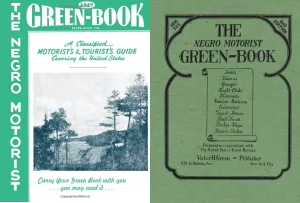1936, and New York City postman Victor Hugo Green publishes the first edition of the Negro Motorist Green-Book. This directory of hotels, restaurants, mechanics, and other services open to Blacks became an indispensable resource for travelers of color. 
Each annual edition grew in size and detail, mapping roads relatively safe from police profiling. “Driving while Black” was a common offense, and it was not unheard of for Black motorists, especially cars full of Black musicians, to disappear while on a road trip. Victor Green also included an ever-growing list of “sundown towns” – cities both north and south not safe for Black motorists after dusk.
Black musicians kept well-thumbed copies of the Green Book close by when touring. The nation’s craving for jazz and dance bands, sadly, outpaced its open-mindedness toward the people who played the music. Drummer “Tootie” Heath recalled that it was “just normal stuff” to be shut out of hotels, not served in restaurants, or denied use of the bathroom.
Pianist Norman Simmons explained that from the Green Book, he knew which restaurants would allow his band to sit and eat, which ones would only let him order food to go, and where they could sleep for the night. Said Simmons, “Sometimes it was a long ways between friendly towns. There were often five of us in the car and we’d just have to take turns driving.”
The Negro Motorist Green-Book helped jazz musicians chart safe routes through Jim Crow America. “I lived through it,” said Tootie Heath, “but a lot of my friends did not.”
“Soundtrack to the Struggle” is hosted by Hollis Monroe. Produced by Ron Adkins. Executive Producer is Dennis Green.
Podcast (soundtrack): Play in new window | Download
Subscribe: Apple Podcasts | RSS


